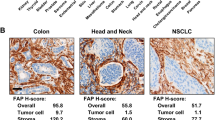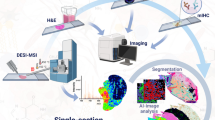Abstract
In the current study the effect of increasing concentrations of superparamagnetic iron oxide labeled cells on the MRI signal decay at magnetic field strengths of 0.2, 1.5, and 3 T was evaluated. The spin echo and gradient echo cellular transverse relaxivity was systematically studied for various concentrations (N = 1, 5, 10, 20, 40, and 80 cells/μlgel) of homogeneously suspended SH U 555A labeled SK-Mel28 human melanoma cells. For all field strengths investigated a linear relationship between cellular transverse relaxation enhancement and cell concentration was found. In the spin echo case, the cellular relaxivities [i.e., d(ΔR 2)/dN] were determined to 0.12 s−1 (cell/μl)−1 at 0.2 T, 0.16 s−1 (cell/μl)−1 at 1.5 T, and 0.17 s−1 (cell/μl) at 3 T. In the gradient echo case, the calculated cellular relaxivities (i.e., d(ΔR *2 )/dN) were 0.51 s−1 (cell/μl)−1 at 0.2 T, 0.69 s−1 (cell/μl)−1 at 1.5 T, and 0.71 s−1 (cell/μl)−1 at 3 T. The proposed preparation technique has proven to be a simple and reliable approach to quantify effects of magnetically labeled cells in vitro. On the basis of this quantification well suited tissue specific models can be derived.
Similar content being viewed by others
References
Bulte JWM, Kraitchman DL (2004) Iron oxide MR contrast agents for molecular and cellular imaging. NMR Biomed 17:484–499
Zhang Z, van den Bos EJ, Wielopolski PA, de Jong-Popijus M, Bernsen MR, Duncker DJ, Krestin GP (2004) High-resolution magnetic resonance imaging of iron-labeled myoblasts using a standard 1.5-T clinical scanner. MAGMA Magn Reson Mater Phys 17:201–209
Bos C, Delmas Y, Desmouliere A, Solanilla A, Hauger O, Grosset C, Dubus I, Ivanovic Z, Rosenbaum J, Charbord P, Combe C, Bulte JWM, Moonen CTW, Ripoche J, Grenier N (2004) In vivo MR imaging of intravascularly injected magnetically labeled mesenchymal stem cells in rat kidney and liver. Radiology 233:781–789
Daldrup-Link HE, Rudelius M, Piontek G, Metz S, Bräuer R, Debus G, Corot C, Schlegel J, Link TM, Peschel C, Rummeny EJ, Oostendorp RAJ (2005) Migration of iron oxide-labeled human hematopoietic progenitor cells in a mouse model: in vivo monitoring with 1.5-T MR imaging equipment. Radiology 234:197–205
De Vries IJM, Lesterhuis WJ, Barentsz JO, Verdijk P, Van Krieken JH, Boerman OC, Oyen WJG, Bonenkamp JJ, Boezeman JB, Adema GJ, Bulte JWM, Scheenen TWJ, Punt CJA, Heerschap A, Figdor CG (2005) Magnetic resonance tracking of dendritic cells in melanoma patients for monitoring of cellular therapy. Nat Biotechnol 23:1407–1413
Hoehn M, Küstermann E, Blunk J, Wiedermann D, Trapp T, Wecker S, Föcking M, Arnold H, Hescheler J, Fleischmann BK, Schwindt W, Bührle C (2002) Monitoring of implanted stem cell migration in vivo: a highly resolved in vivo magnetic resonance imaging investigation of experimental stroke in rat. Proc Natl Acad Sci USA 99:16267–16272
Zhao M, Beauregard DA, Loizou L, Davletov B, Brindle KM (2001) Non-invasive detection of apoptosis using magnetic resonance imaging and a targeted contrast agent. Nat Med 7:1241–1244
Boutry S, Burtea C, Laurant S, Toubeau G, Vander Elst L, Muller RN (2005) Magnetic resonance imaging of inflammation with a specific selectin-targeted contrast agent. Magn Reson Med 53:800–807
Dodd SJ, Williams M, Suhan JP, Williams DS, Koretsky AP, Ho C (1999) Detection of single mammalian cells by high-resolution magnetic resonance imaging. Biophys J 76:103–109
Foster-Gareau P, Heyn C, Alejski A, Rutt BK (2003) Imaging single mammalian cells with a 1.5 T clinical MRI scanner. Magn Reson Med 49:968–971
Hinds KA, Hill JM, Shapiro EM, Laukkanen MO, Silva AC, Combs CA, Varney TR, Balaban RS, Koretsky AP, Dunbar CE (2003) Highly efficient endosomal labeling of progenitor and stem cells with large magnetic particles allows magnetic resonance imaging of single cells. Blood 102:867–872
Zhang Z, van den Bos EJ, Wielopolski PA, de Jong-Popijus M, Bernsen MR, Duncker DJ, Krestin GP (2005) In vitro imaging of single living umbilical vein endothelial cells with a clinical 3.0-T MRI sanner. MAGMA Magn Reson Mater Phys 18:175–185
Matuszewski L, Persigehl T, Wall A, Schwindt W, Tombach B, Fobker M, Poremba C, Ebert W, Heindel W, Bremer C (2005) Cell tagging with clinically approved iron oxides: feasibility and effect of lipofection, particle size, and surface coating on labeling efficiency. Radiology 235:155–161
Daldrup-Link HE, Rudelius M, Oostendorp RAJ, Settles M, Piontek G, Metz S, Rosenbrock H, Keller U, Heinzmann U, Rummeny EJ, Schlegel J, Link TM (2003) Targeting of hematopoietic progenitor cells with MR contrast agents. Radiology 228:760–767
Metz S, Bonaterra G, Rudelius M, Settles M, Rummeny EJ, Daldrup-Link HE (2004) Capacity of human monocytes to phagocytose approved iron oxide MR contrast agents in vitro. Eur Radiol 14:1851–1858
Simon GH, Bauer J, Saborovski O, Fu Y, Corot C, Wendland MF, Daldrup-Link HE (2005) T1 and T2 relaxivity of intracellular and extracellular USPIO at 1.5 T and 3 T clinical MR scanning. Eur Radiol 25:1–8
Bowen CV, Zhang X, Saab G, Gareau PJ, Rutt B (2002) Application of the static dephasing regime theory to superparamagnetic iron-oxide loaded cells. Magn Reson Med 48:52–61
Ziener CH, Bauer WR, Jakob PM (2005) Transverse relaxation of cells labeled with magnetic nanoparticles. Magn Reson Med 54:702–706
Yablonskiy DA, Haacke EM (1994) Theory of NMR signal behavior in magnetically inhomogeneous tissues: the static dephasing regime. Magn Reson Med 32:749–763
Rohrer M, Bauer H, Mintorovitch J, Requardt M, Weinmann HJ (2005) Comparison of magnetic properties of MRI contrast media solutions at different magnetic field strengths. Invest Radiol 40:715–723
Fisel CR, Ackerman JL, Buxton RB, Garrido L, Belliveau JW, Rosen BR, Brady TJ (1991) MR contrast due to microscopically heterogeneous magnetic susceptibility: numerical simulations and applications to cerebral physiology. Magn Reson Med 17:336–347
Hardy PA, Henkelman RM (1989) Transverse relaxation rate enhancement caused by magnetic particulates. Magn Reson Imaging 7:265–275
Roch A, Muller RN (1999) Theory of proton relaxation induced by superparamagnetic particles. J Chem Phys 110:5403–5411
Pintaske J, Müller-Bierl B, Schick F (2006) Effect of spatial distribution of magnetic dipoles on lamor frequency distribution and MR signal decay – a numerical approach under static dephasing conditions. MAGMA Magn Reson Mater Phys 19:46–53
Falkenhausen M, Meyer C, Lutterbey G, Morakkabati-Spitz N, Gieseke J, Reichel C, Blömer R, Kuhl CK, Schild HH (2005) Contrast enhanced MRI of the liver with SPIO at 3 T. Does the higher field strength translate into higher contrast? RoeFo 177:582
Author information
Authors and Affiliations
Corresponding author
Rights and permissions
About this article
Cite this article
Pintaske, J., Bantleon, R., Kehlbach, R. et al. Effect of Concentration of SH U 555A Labeled Human Melanoma Cells on MR Spin Echo and Gradient Echo Signal Decay at 0.2, 1.5, and 3T. Magn Reson Mater Phy 19, 71–77 (2006). https://doi.org/10.1007/s10334-006-0029-z
Received:
Accepted:
Published:
Issue Date:
DOI: https://doi.org/10.1007/s10334-006-0029-z




